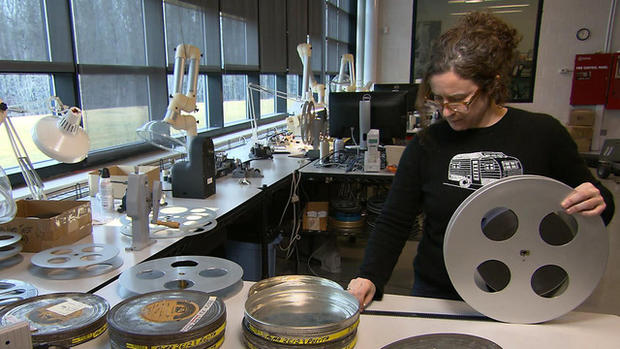MoMA's race to preserve film classics
In the film archives of New York City's Museum of Modern Art, curators are trying to restore a 1923 silent film classic, "Rosita." The film stars Mary Pickford, one of America's first film icons, and it's the only surviving complete print of the film, reports "CBS This Morning: Saturday" co-host Anthony Mason.
"This actual print was 4K-scanned in a lab, and now they're in the process of going through it, like literally frame by frame," MoMA films collection manager Katie Trainor said.
MoMA's film archive, started in 1935, is the oldest in the world. It's so influential that in 1977 the Academy honored the museum for its pioneering work in film preservation with an Oscar.
Chief curator of the film collection Raj Roy said as MoMA's library expanded, it outgrew the museum's New York City location. So a sprawling storage facility was built in Hamlin, Pennsylvania.
"It's cold in here," Mason observed, entering the facility.
"It's very cold. Yeah, all the better to keep these," Roy said. "So at this temperature, about 35 degrees, relatively dry, we can keep these for almost 400 years."
It is just one of more than 50 storage vaults for 25,000 titles -- everything from experimental films to classics like "The Birth of a Nation," "The Grapes of Wrath" and "The Third Man."
"One of our favorites, a little film called 'Citizen Kane,' right here... We keep these all flat, dry, cold," Roy said. "Having analog storage version is always the best thing. It's what lets me sleep at night that we have all this."
MoMA also archives posters, ephemera and records from distributors and studios, Roy said. It includes the studio scrapbook of press clippings from "Gone with the Wind"'s 1939 premiere, which includes a page on the black actors in the film.
"'The darker side of "Gone with the Wind,"'" Roy read out loud.
MoMA's work restoring "Rosita" will in all take about two years. It'll bring back a major Mary Pickford film that was also the first American movie by legendary German director Ernst Lubitsch.
"So how does a film like that disappear?" Mason asked Dave Kehr, head of film preservation at MoMA.
"Mary apparently took a personal dislike to it, for reasons that are still not completely clear. ... It seems that she deliberately allowed the film to deteriorate," Kehr explained. "She didn't renew the copyright on the film."
But MoMA discovered a copy in the Soviet Union in the 1970s.
"In horrible condition. ... And it was just too much for the technology of that time to handle," Kehr said.
But "Rosita"'s time has come, and Kehr wishes more films could be restored to the quality of Douglas Fairbanks' final film, "The Iron Mask," made in 1929.
"This is a very crisp copy because it has been made directly from the original camera negative, the actual film that passed through the cameras on the set," Kehr said.
But even showing these films will become challenging. Thirty-five-millimeter projectors are no longer manufactured, and Kehr said spare parts will keep existing projectors going only for another decade.
"But after that, we have to start digitizing this massive collection, which is such a huge undertaking, it just makes my head explode," Kehr said.
"Do you feel like you're in a race?" Mason asked.
"It's getting there. I don't think that the seriousness of this has really settled in, even in the archival community," Kehr said. "I'm still convinced that movies are absolutely what America did best in the 20th century. And that's, you know, our defining art form. And I don't want to lose one frame of that stuff. I really don't."

